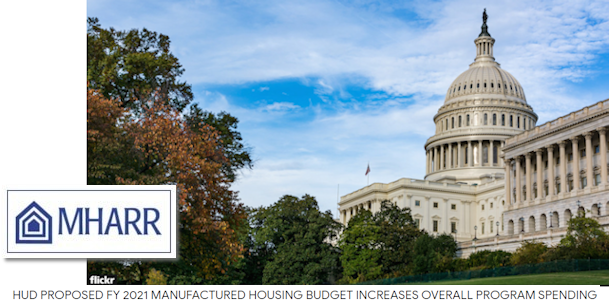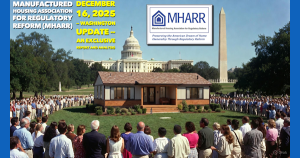HUD Proposed FY 2021 Manufactured Housing Budget Increases Overall Program Spending

President Trump’s proposed Fiscal Year (FY) 2021 budget for the U.S. Department of Housing and Urban Development (HUD) would once again increase funding for the federal manufactured housing program — with the bulk of the increase going to program contractors – notwithstanding lower production levels in 2019.
In the White House budget blueprint and related materials released on February 10, 2020, overall funding for the federal program would grow to $14 million, an increase of $1 million over the $13 million appropriated by Congress in FY 2020, and an increase of $2 million over the $12 million in program funding sought by the Administration in the FY 2020 budget.
The bulk of this increase, as detailed in HUD’s FY 2021 Congressional Budget Justifications, would go to manufactured housing program contractors, with a budgeted increase of $1.1 million in payments to all contractors, including the program monitoring contractor, again, despite a 2% decline in overall industry production in 2019. MHARR has long opposed any increases in contractor funding and particularly funding for the program monitoring contractor which, as demonstrated repeatedly by MHARR, wields disproportionate authority within the HUD regulatory system, performing multiple functions that are governmental in nature and therefore unlawful for delegation to a private contractor. MHARR has thus consistently pressed for reductions in contractor funding, combined with increases in payments to State Administrative Agencies (SAAs). Based on this longstanding position, MHARR will continue to seek reductions in program contract spending and spending on the monitoring contract in particular.
With regard to SAA funding, the proposed FY 2021 budget does contain some positive news. Under the FY 2021 proposal, budgeted funding for state SAAs would increase by $900,000.00 to $4.5 million for all SAAs. An increase in SAA funding, to ensure continuing state participation in the HUD program and to encourage additional states to become involved, has been an MHARR priority since the enactment of the Manufactured Housing Improvement Act of 2000. For more than a decade, however, such funding increases have been actively resisted by HUD program officials, leading at least one state to leave the HUD program. In response, MHARR has engaged continually with Congress and, in fact, MHARR-proposed language seeking increased SAA funding has appeared in Appropriations Committee reports on HUD manufactured housing program budgets since at least 2011.
At the same time, though, further delays in distributing this additional funding are possible. HUD’s Congressional Justifications thus indicate that the program will “reassess both its current SAA payment structure and the revised payment structure proposed in 2016 in order to ensure a more equitable distribution of funds among states….” (Emphasis added). It is, therefore, possible, if not likely, that HUD will make changes to its 2016 proposed rule (which MHARR generally supported), or may begin a new rulemaking proceeding on SAA funding altogether, causing further delays. Regardless, MHARR will continue to press for proper SAA funding, corresponding reductions in contractor funding, and the expeditious enactment of a final SAA funding rule.
In addition, and beyond these matters, MHARR (as it has consistently) will continue to press for the appointment of a dedicated, non-career, appointed Administrator for the federal manufactured housing program, as required by the Manufactured Housing Improvement Act of 2000 and acknowledged by HUD in its 2019 Housing Finance Reform Plan.
President Trump’s proposed Fiscal Year (FY) 2021 budget for the U.S. Department of Housing and Urban Development (HUD) would once again increase funding for the federal manufactured housing program — with the bulk of the increase going to program contractors – notwithstanding lower production levels in 2019.
In the White House budget blueprint and related materials released on February 10, 2020, overall funding for the federal program would grow to $14 million, an increase of $1 million over the $13 million appropriated by Congress in FY 2020, and an increase of $2 million over the $12 million in program funding sought by the Administration in the FY 2020 budget.
The bulk of this increase, as detailed in HUD’s FY 2021 Congressional Budget Justifications, would go to manufactured housing program contractors, with a budgeted increase of $1.1 million in payments to all contractors, including the program monitoring contractor, again, despite a 2% decline in overall industry production in 2019. MHARR has long opposed any increases in contractor funding and particularly funding for the program monitoring contractor which, as demonstrated repeatedly by MHARR, wields disproportionate authority within the HUD regulatory system, performing multiple functions that are governmental in nature and therefore unlawful for delegation to a private contractor. MHARR has thus consistently pressed for reductions in contractor funding, combined with increases in payments to State Administrative Agencies (SAAs). Based on this longstanding position, MHARR will continue to seek reductions in program contract spending and spending on the monitoring contract in particular.
With regard to SAA funding, the proposed FY 2021 budget does contain some positive news. Under the FY 2021 proposal, budgeted funding for state SAAs would increase by $900,000.00 to $4.5 million for all SAAs. An increase in SAA funding, to ensure continuing state participation in the HUD program and to encourage additional states to become involved, has been an MHARR priority since the enactment of the Manufactured Housing Improvement Act of 2000. For more than a decade, however, such funding increases have been actively resisted by HUD program officials, leading at least one state to leave the HUD program. In response, MHARR has engaged continually with Congress and, in fact, MHARR-proposed language seeking increased SAA funding has appeared in Appropriations Committee reports on HUD manufactured housing program budgets since at least 2011.
At the same time, though, further delays in distributing this additional funding are possible. HUD’s Congressional Justifications thus indicate that the program will “reassess both its current SAA payment structure and the revised payment structure proposed in 2016 in order to ensure a more equitable distribution of funds among states….” (Emphasis added). It is, therefore, possible, if not likely, that HUD will make changes to its 2016 proposed rule (which MHARR generally supported), or may begin a new rulemaking proceeding on SAA funding altogether, causing further delays. Regardless, MHARR will continue to press for proper SAA funding, corresponding reductions in contractor funding, and the expeditious enactment of a final SAA funding rule.
In addition, and beyond these matters, MHARR (as it has consistently) will continue to press for the appointment of a dedicated, non-career, appointed Administrator for the federal manufactured housing program, as required by the Manufactured Housing Improvement Act of 2000 and acknowledged by HUD in its 2019 Housing Finance Reform Plan.












